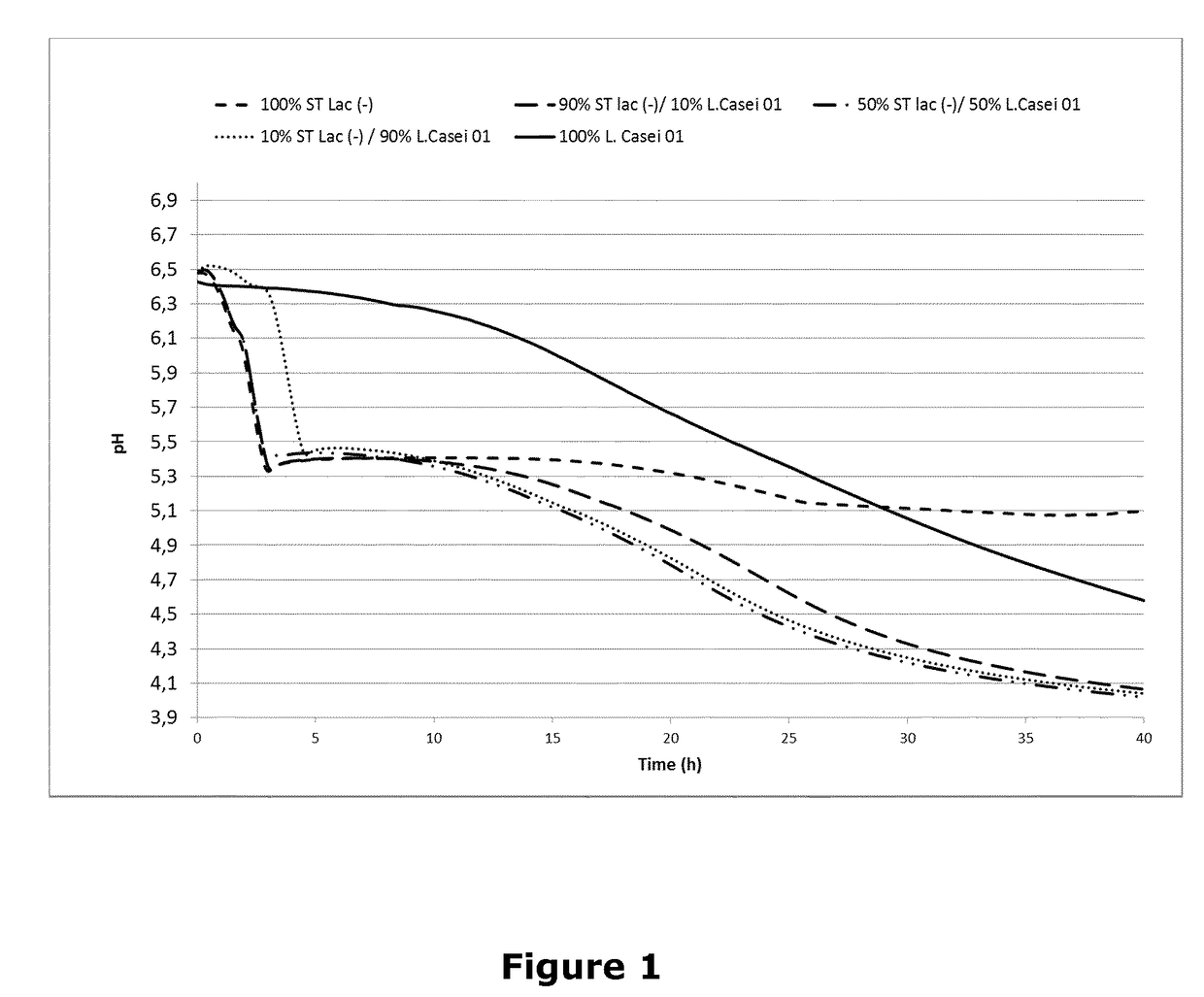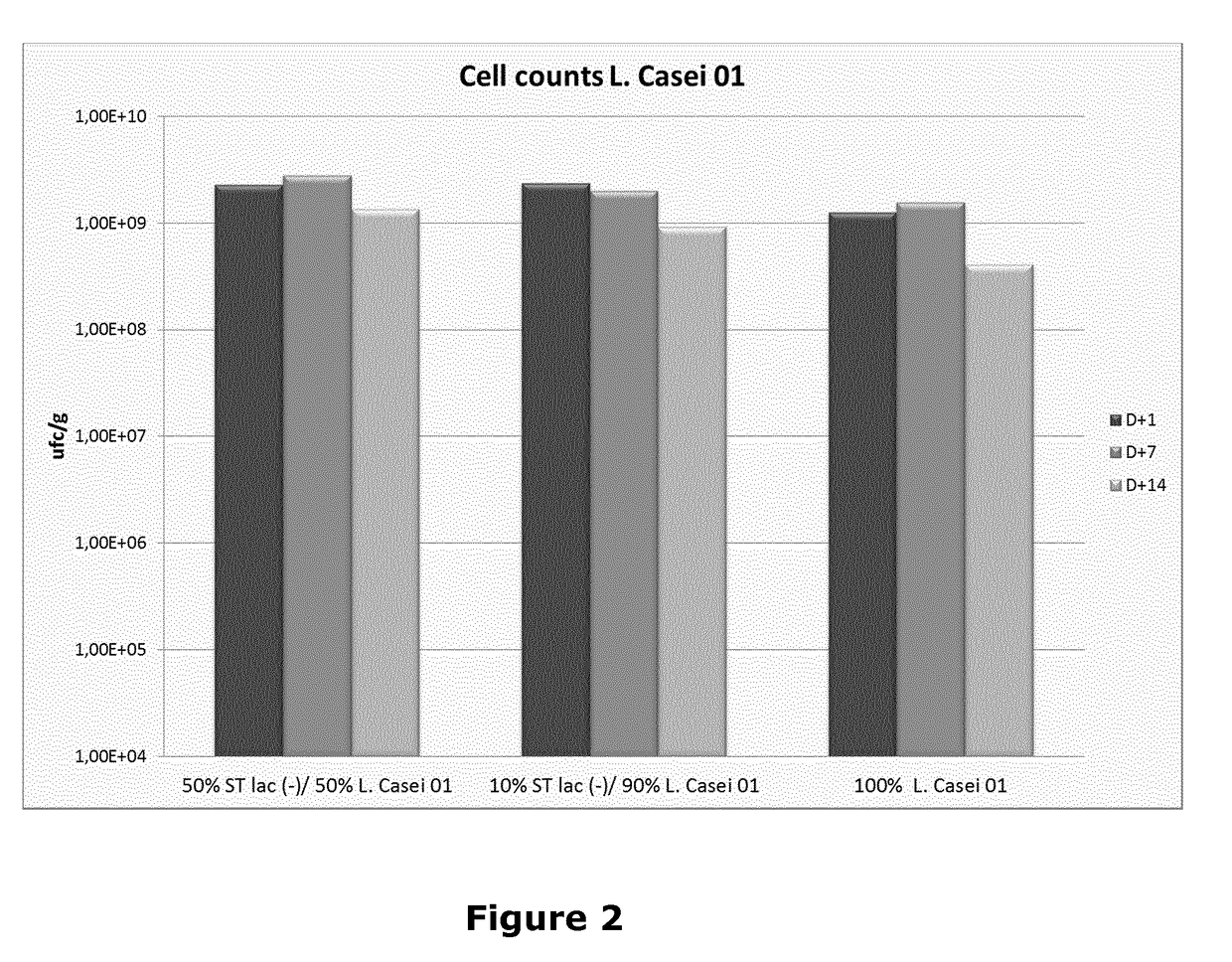Method of producing a fermented milk product using lactobacillus casei
- Summary
- Abstract
- Description
- Claims
- Application Information
AI Technical Summary
Benefits of technology
Problems solved by technology
Method used
Image
Examples
example 1
[0107]FITC Assay: Protocol for measuring Proteinase activity in lactic acid bacteria (LAB), employing Hamilton liquid handling unit.
[0108]The cell-wall associated proteinase(s) contribute to rapid growth of LAB in milk. The proteinases are also responsible for the first step in degradation of casein and thereby development of flavor. The assay is based on the fluorescent substrate fluorescein isothiocyanate labeled casein (FITC).
[0109]Materials[0110]Costar Deep well plate—2.0 ml[0111]Microtiter plates: Nunc, black plates, (Cat. No. 237105), Nunc (product no. 167008),[0112]MJR PCR plate (V-shaped, product no. HSP-9665)[0113]Hamilton liquid handling robot[0114]Hamilton disposable sterile tips[0115]Calcium chloride dihydrate (Merck Cat. No. 1.02382.1000)[0116]MES hydrate, minimum 99.5% titration (Sigma M8250-1 kg)[0117]Tris, (Sigma Cat. No. 11503)[0118]Samples in Costar deep well plate (2.0 ml)[0119]Enspire, 2300 multilabel reader, PerkinElmer[0120]Control strains: LH-Emfour, batch no....
example 2
[0148]Milk was fermented using one of the following two different L. casei strains of Chr. Hansen alone or in combination with the following Streptococcus thermophilus strain of Chr. Hansen:[0149]L. casei CRL 431 deposited as ATCC 55544;[0150]L. casei 01, CHCC2115 deposited as DSM19465; and[0151]S. thermophilus, CHCC17861 deposited as S. thermophilus DSM 28952.
[0152]The S. thermophilus strain has a deficiency in lactose metabolism.
[0153]When used in combination the following ratios were used:[0154](1) 50:50[0155](2) 90:90; and[0156](3) 10:90.
[0157]S. thermophilus with a deficiency in lactose metabolism alone and each of the two L. casei strains alone were used as controls.
[0158]Standard milk was used for the trials (3.8% protein, 1.5% fat). Sucrose (0.4% w / v) was added to the milk to allow fast acidification of the S. thermophilus with a deficiency in lactose metabolism to pH 5.50. Acidification was performed at 39° C. and at 37° C.
[0159]Development of pH was determined during ferme...
example 3
[0165]Milk was fermented using the following L. casei strain of Chr. Hansen alone or in combination with the following Streptococcus thermophilus strains of Chr. Hansen:
[0166]L. casei CRL 431 deposited as ATCC 55544; in combination with
1) S. thermophilus, CHCC17861 deposited as S. thermophilus DSM 28952. The strain has a deficiency in lactose metabolism (Lac(−)); or
2) S. thermophilus, CHCC11977 deposited as DSM22935, with no deficiency in lactose metabolism (mother strain of CHCC17861) (Lac(+)).
[0167]When used in combination the following ratio was used:[0168](1) 50:50
[0169]The milk base used for the present experiment is Skimmed Milk Powder (SMP) reconstituted at 9.6%. The milk base was subjected to heat treatment at 99° C. for 15 minutes. Sucrose (0.3% w / v) was added to the milk to allow fast acidification of the S. thermophilus with a deficiency in lactose metabolism to pH 5.50. Acidification was performed at 39° C.
[0170]Development of cell count was determined 40 hours after fer...
PUM
 Login to View More
Login to View More Abstract
Description
Claims
Application Information
 Login to View More
Login to View More - R&D
- Intellectual Property
- Life Sciences
- Materials
- Tech Scout
- Unparalleled Data Quality
- Higher Quality Content
- 60% Fewer Hallucinations
Browse by: Latest US Patents, China's latest patents, Technical Efficacy Thesaurus, Application Domain, Technology Topic, Popular Technical Reports.
© 2025 PatSnap. All rights reserved.Legal|Privacy policy|Modern Slavery Act Transparency Statement|Sitemap|About US| Contact US: help@patsnap.com



